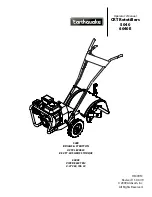
13
Section 4: Operating Procedures
11/26/14
TB2596 & TB25108 Trip Blade 301-291M
Section 4: Operating Procedures
Pre-Start Checklist
Hazard control and accident prevention are dependent
upon the awareness, concern, prudence, and proper
training involved in the operation, transport, storage, and
maintenance of the Trip Edge Blade. Therefore, it is
absolutely essential that no one operates the Trip Edge
Blade without first having read, fully understood, and
become totally familiar with the Operator’s Manual. Make
sure the operator has completed the Operating Checklist
below.
General Safety Information
!
CAUTION
Refer to Figure 1-1 on page 8:
Always check all hardware for tightness before using the
blade. The moldboard will fall off if any of the three pivot pin
retaining bolts (#5) are missing
•
Do not let children operate the implement.
•
Do not allow anyone to operate this implement who
has not been properly trained in its safe operation.
•
Never allow passengers on the tractor/skid steer or
carry a rider on the implement.
•
Always dress to stay warm in cold weather. Never
allow your body or extremities to become too cold. If
you are getting cold, go inside to warm-up before
continuing.
•
Always exercise safety, courtesy, and common sense.
Be aware of pedestrian and vehicle traffic. Check blind
spots before moving equipment. Move snow during
low-traffic hours.
•
Make sure all safety labels are in their proper location
and in good readable condition before operating.
Operating Checklist
✔
Check
Page
Read & follow all safety rules & safety decals
carefully.
Refer to “Important Safety Information”.
Make sure all guards and shields are in place.
Refer to “Important Safety Information”.
Read & follow hook-up & preparation
instructions.
Refer to “Section 1: Assembly & Set-up”.
Read & make all required adjustments.
Refer to “Section 3: Adjustments”.
Read and follow all operating procedures.
Refer to “Section 4: Operating Procedures”.
Read & follow all maintenance Instructions.
Refer to “Section 5: Maintenance & Lubrication”.
Read & follow all lubrication instructions.
Refer to “Lubrication Points”.
Check Trip Edge Blade initially and periodically
for loose bolts and pins.
Refer to “Torque Values Chart”.
•
Keep blade properly attached to the power equipment
when in use.
•
Keep hands, feet, hair, and clothing away from moving
parts and pinch points.
•
The Trip Edge Blade is designed primarily for moving
snow. It may also be used to move small amounts of
light aggregate materials such as pea gravel, grain,
and loose soil. Do not use the blade to move
undisturbed soil, heavy materials, gravel, rocks, or
similar items.
•
Protect against equipment falling unexpectedly. Lower
blade to ground or securely block blade up with
support blocks before servicing or working under and
around the unit.
•
Do not alter the Trip Edge Blade in any manner.
•
Use the Trip Edge Blade for its intended purpose only.
Do not use it for pulling, pushing, or lifting objects.
•
Always wear the seat belt when moving and lower the
seat bar if equipped with the skid steer.
•
Make sure controls are all in neutral position before
starting the tractor/skid steer.
•
Do not move snow at high speeds. High speeds can
result in sudden loss of control leading to damaged
property, equipment, and bodily harm.
•
Do not hit solid objects with the blade. Mark locations
of all curbs, hydrants, stumps, and other obstructions
in the area that can damage the equipment and
property when hit.
!
WARNING
Use stepping pads on the hitch plate and hand holds on the
skid steer when climbing into the skid steer cab. Never step on
smooth surfaces or on the blade. Feet can slip on smooth
surfaces especially if wet or icy and the blade can suddenly
shift if pivot control pin has not been properly inserted.
Trip Blade Stepping Pads
Figure 4-1
26919
Pivot Control Pin
















































